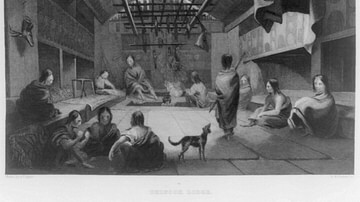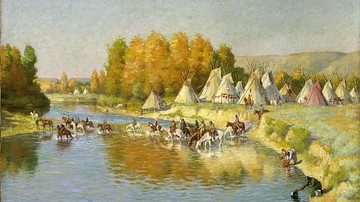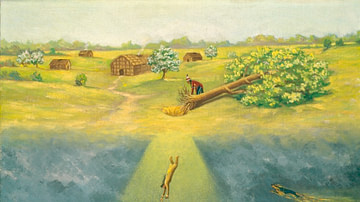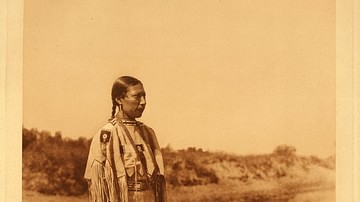The Jicarilla-Apache Creation Story and Origin of the Animals are two origin myths of the Jicarilla-Apache nation of modern-day New Mexico. The Apache people as a whole have many different creation tales, as do the Jicarilla, but all follow the same basic model of a supernatural entity creating the world from nothing.
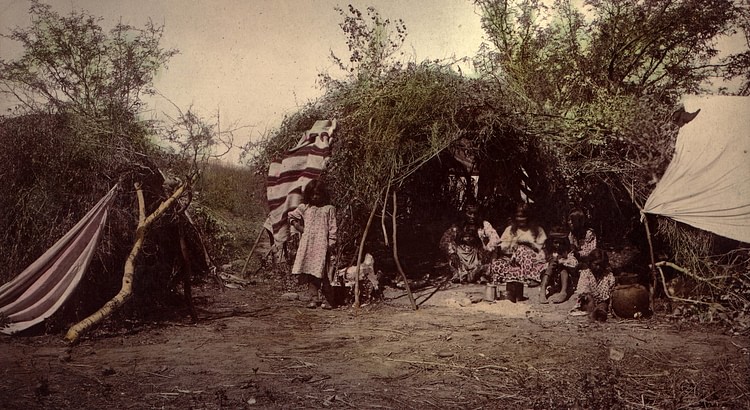
The Jicarilla's Origin of the Animals shares similarities with the same sort of legend from many other Native peoples of North America. There are several origin myths that feature the detail of the first animals emerging from under the ground – just as there are many creation stories, involving humans coming up from below the earth, that follow that same paradigm – and this detail is so popular because it reminded the people of their ancient connection to the land they lived on. Their ancestors, and those of all the animals, had once come up from beneath the ground, and so the earth was viewed as the Great Mother and should be respected and cared for accordingly.
Apache Nation & Importance of Stories
The Apache people call themselves Dini (Dine), Tinde, Tinneh ("the people"), and the different bands are related by their shared Athapascan language. They are thought to have been given the name Apache ("enemy") by the Zuni nation, though this claim has been challenged. They are linguistically related to the Athabaskan-speaking Navajo, who also refer to themselves as Dine (pronounced DEE-Nay). In time, the Apache came to apply that name to themselves and inhabited the region of the Southwest and Southern Plains of modern-day USA. There are six bands which comprise the Apache nation and subbands within those:
- Chiricahua
- Jicarilla
- Lipan
- Mescalero
- Plains Apache
- Western Apache
Among the best-known Apache figures from Euro-American history are the resistance leaders Mangas Coloradas (l. c. 1793-1863), Cochise (l. c. 1805-1874), Victorio (l. c. 1825-1880), Victorio's sister, Lozen (l. c. 1840-1889), and Geronimo (l. 1829-1909).
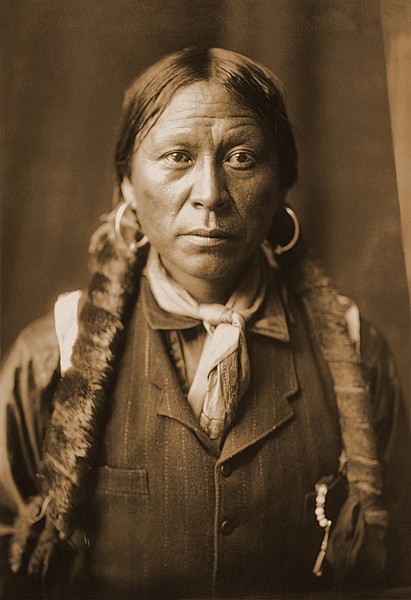
The Apache first came into conflict with Europeans when the Spanish invaded their lands in the 1500s and, later, mounted resistance against the Euro-Americans before, and after, they seized control of Mexican lands in 1848. By 1900, the Apache had been forcibly relocated from their ancestral lands and confined to reservations by the US government. They have kept their culture alive through their language, practicing their religion, and observing traditional customs, including storytelling. The following two tales are among the best-known, relating the creation of the world and the establishment of the relationship between the people and animals.
Text
The following tales come from Myths and Tales of the Jicarilla Apache Indians: Memoirs of the American Folktale Society (1995) by Morris Edward Opler (Creation Story) and from Voices of the Winds: Native American Legends (2021) by Margot Edmonds and Ella Clark (Origin of the Animals).
Jicarilla-Apache Creation Story
In the beginning there was nothing – no earth, no living beings. There were only darkness, water, and Cyclone, the wind. There were no humans, but only the Hactcin, the Jicarilla supernatural beings. The Hactcin made the earth, the underworld beneath it, and the sky above it. The earth they made as a woman who faces upward, and the sky they made as a man who faces downward.
The Hactcin lived in the underworld, where there was no light. There were mountains and plants in the underworld, and each had its own Hactcin. There were as yet no animals or humans, and everything in the underworld existed in a dream-like state and was spiritual and holy.
The most powerful of the Hactcin in the underworld was Black Hactcin. One day Black Hactcin made the first animal with four legs and a tail made of clay. At first, he thought it looked peculiar, but when he asked it to walk and saw how gracefully it walked, he decided it was good. Knowing this animal would be lonely, he made many other kinds of animals come from the body of the first.
He laughed to see the diversity of the animals he had created. All the animals wanted to know what to eat and where to live, so he divided the foods among them, giving grass to the horse, sheep, and cow, and to others he gave brush, leaves, and pine needles. He sent them out to different places, some to the mountains, some to the deserts, and some to the plains, which is why the animals are found in different places today.
Next Black Hactcin held out his hand and caught a drop of rain. He mixed this with some earth to make mud and made a bird from the mud. At first, he wasn't sure he would like what he had made. He asked the bird to fly, and when it did, he liked it. He decided the bird too would be lonely, so he grabbed it and whirled it rapidly clockwise.
As the bird became dizzy, it saw images of other birds, and when Black Hactcin stopped whirling it, there were indeed many new kinds of birds, all of which live in the air because they were made from a drop of water that came from the air. Black Hactcin sent the birds out to find places they liked to live, and when they returned, he gave each the place that they liked.
To feed them, he threw seeds all over the ground. To tease them, however, he turned the seeds into insects, and he watched as they chased after the insects. At a river nearby, he told the birds to drink. Again, however, he couldn't resist teasing them, so he took some moss and made fish, frogs, and the other things that live in water. This frightened the birds as they came to drink, and it is why birds so often hop back in fright as they come down to drink. As some of the birds took off, their feathers fell in the water, and from them came the ducks and other birds that live in the water.
Black Hactcin continued to make more animals and birds. The animals and birds that already existed all spoke the same language, and they held a council. They came to Black Hactcin and asked for a companion. They were concerned that they would be alone when Black Hactcin left them, and Black Hactcin agreed to make something to keep them company. He stood facing the east, and then the south, and then the west, and then the north.
He had the animals bring him all sorts of materials from across the land, and he traced his outline on the ground. He then set the things that they brought him in the outline. The turquoise that they brought became veins, the red ochre became blood, the coral became skin, the white rock became bones, the Mexican opal became fingernails and teeth, the jet became the pupil, the abalone became the white of the eyes, and the white clay became the marrow of the bones. Pollen, iron ore, and water scum were used too, and Black Hactcin used a dark cloud to make the hair.
The man they had made was lying face down, and it began to rise as the birds watched with excitement. The man arose from prone, to kneeling, to sitting up, and to standing. Four times Black Hactcin told him to speak, and he did. Four times Black Hactcin told him to laugh, and he did. It was likewise with shouting. Then Black Hactcin taught him to walk and had him run four times in a clockwise circle.
The birds and animals were afraid the man would be lonely, and they asked Black Hactcin give him company. Black Hactcin asked them for some lice, which he put on the man's head. The man went to sleep scratching, and he dreamed that there was a woman beside him. When he awoke, she was there. They asked Black Hactcin what they would eat, and he told them that the plants and the cloven-hoofed animals would be their food. They asked where they should live. He told them to stay anywhere they liked, which is why the Jicarilla move from place to place.
These two, Ancestral Man and Ancestral Woman, had children, and the people multiplied. In those days no one died, although they all lived in darkness. This lasted for many years. The Hactcins made a sun and moon, but they could only be seen through a hole in the dark sky. To solve the problem, White Hactcin turned to the animals and had them bring the foods they ate.
With the food and some sand and water, they began to grow a mountain. The mountain grew, but it stopped short of the hole in the sky that led from the underworld to the earth that we know. The Hactcins sent up Fly and Spider, who took four rays of the sun and built a rope ladder to the upper world.
The Hactcins called for the people to climb up, and for four days they climbed the mountain. At the top they found four ladders. Ancestral Man and Ancestral Woman were the first people to climb up, and the people climbed up into the upper world that we know today. Thus, the earth is our mother, and the people climbed up as from a womb.
Then the animals came up, and before long the ladders were worn out. Behind the animals came an old man and an old woman, and they couldn't climb the ladders. No one could get them up, and finally the two realized they had to stay in the underworld. They agreed to stay but told the others they must come back to the underworld eventually, which is why people go to the underworld after death.
Everything in the upper world is alive - the rocks, the trees, the grass, the plants, the fire, the water. Originally, they all spoke the Jicarilla Apache language and spoke to the people. Eventually the people travelled out clockwise across the land. Different groups would break off and stay behind, and their children would begin to play games in which they used odd languages.
The people in these groups began to forget their old languages and use these new ones, which is why now there are many languages. Only one group kept on traveling in the clockwise spiral until they reached the center of the world, and these are the Jicarilla Apaches.
Origin of the Animals
When Apaches emerged from the underworld, they traveled southward for four days. They had no other food than two kinds of seeds, which they ground between two stones.
Near where they camped on the fourth night, one teepee stood apart from the others. While the owner and his wife were absent for a short time, a Raven brought a quiver of arrows and a bow, hanging them on the lodgepole. When the children came out of the lodge, they took down the quiver and found some meat inside. They ate it and instantly became very fat.
Upon her return, the mother noticed grease on the hands and faces of her children, who told her what had happened. The woman hurried to tell her husband the tale. All the tribe marveled at the wonderful food that made the children so fat. How they hoped the Raven might soon return with more of his good food.
When Raven discovered that his meat had been stolen, he flew eastward to his mountain home beyond the normal range of man. A bat followed Raven and, later, informed the Apaches where Raven lived. That night, the Apache Chief called a council meeting. They decided to send a delegation to try and obtain some of Raven's special kind of meat.
In four days, the Apache delegation reached the camp of the ravens, but could not obtain the information they desired. They discovered, however, a great circle of ashes where the ravens ate their meals. The Apaches decided to spy upon the ravens. That night, the Medicine Man changed an Apache boy into a puppy to spy from a nearby bush. The main delegation broke camp and started homeward, leaving behind the puppy.
Next morning, the ravens examined the abandoned camp of the Apaches. One of the young ravens found the puppy and was so pleased, he asked for permission to keep it under his blanket. Toward sunset, the puppy peaked out and saw an old raven brush aside some ashes from the fireplace. He then removed a large flat stone. Beneath was an opening through which the old raven disappeared. But, when he returned, he led a buffalo, which was then killed and eaten by all the ravens.
For four days the puppy spied on the ravens, and each evening a buffalo was brought up from the depths and devoured. Now that he was certain where the ravens obtained their good food, the puppy resumed his normal shape.
Early on the fifth morning, with a white feather in one hand and a black one in the other, he descended through the opening beneath the fireplace.
In the underworld, he saw four buffalo and placed the white feather in the mouth of the nearest one. He commanded it to follow him. But the first buffalo told him to take the feather to the last buffalo. This he did, but the fourth buffalo sent him again to the first one, into whose mouth the boy thrust the white feather.
"You are now the King of the Animals," declared the boy.
Upon returning to the above-world, the boy was followed by all the animals present upon the earth at that time. As the large herd passed through the opening, one of the ravens awoke, hurrying to close the lid. Upon seeing that all the animals willingly followed the Apache boy, the raven exclaimed, "When you kill any of the animals, remember to save the eyes for me."
For four days, the boy followed the tracks of the Apache and overtook them with his great herd of animals. Soon, they all returned to the camp of the Apache, where the Chief slew the first buffalo for a feast that followed. The boy remembered – and saved the eyes for the ravens.
One old grandmother who lived in a brush lodge was annoyed with one of the deer that ate some of her lodge covering. Snatching up a stick from the fire, she struck the deer's nose and the white ash stuck there, leaving a white mark that can still be seen on the descendants of that deer.
"Hereafter, you shall avoid mankind," she pronounced. "Your nose will tell you when you are too close to them."
Thus ended the short period of harmony between man and the animals. Each day the animals wandered farther and farther from the tribes. Apaches prayed that the animals would return so they could enjoy the good meat again. It is mostly at night when the deer appear, but not too close, because the old grandmother told them to be guided by their noses.
Apaches developed skill in using the bows and arrows to hunt the good animal meat they liked so much, especially the buffalo.

